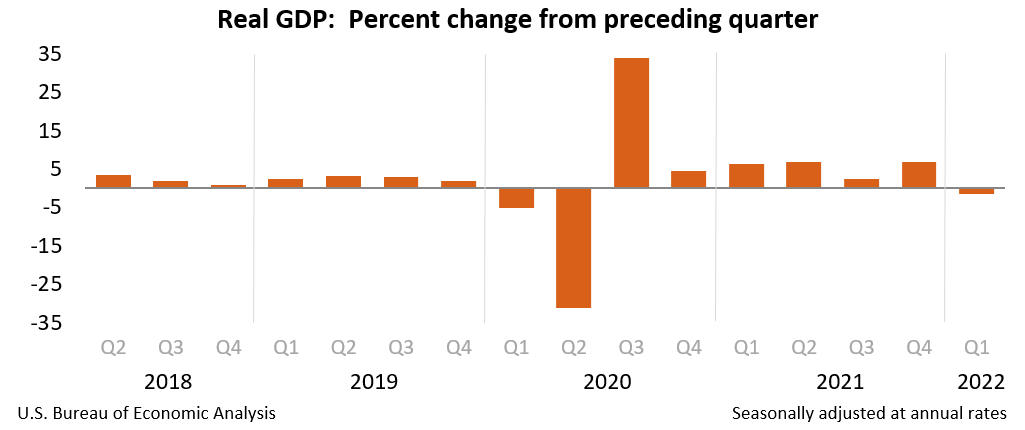Washington, DC…Real gross domestic product (GDP) decreased at an annual rate of 1.4 percent in the first quarter of 2022 (table 1), according to the “advance” estimate released by the Bureau of Economic Analysis. In the fourth quarter, real GDP increased 6.9 percent. The GDP estimate released today is based on source data that are incomplete or subject to further revision by the source agency (refer to “Source Data for the Advance Estimate” on page 3). The “second” estimate for the first quarter, based on more complete data, will be released on May 26, 2022
The decrease in real GDP reflected decreases in private inventory investment, exports, federal government spending, and state and local government spending, while imports, which are a subtraction in the calculation of GDP, increased. Personal consumption expenditures (PCE), nonresidential fixed investment, and residential fixed investment increased (table 2).
The decrease in private inventory investment was led by decreases in wholesale trade (mainly motor vehicles) and retail trade (notably, “other” retailers and motor vehicle dealers). Within exports, widespread decreases in nondurable goods were partly offset by an increase in “other” business services (mainly financial services). The decrease in federal government spending primarily reflected a decrease in defense spending on intermediate goods and services. The increase in imports was led by increases in durable goods (notably, nonfood and nonautomotive consumer goods).
The increase in PCE reflected an increase in services (led by health care) that was partly offset by a decrease in goods. Within goods, a decrease in nondurable goods (led by gasoline and other energy goods) was partly offset by an increase in durable goods (led by motor vehicles and parts). The increase in nonresidential fixed investment reflected increases in equipment and intellectual property products.
Current‑dollar GDP increased 6.5 percent at an annual rate, or $379.9 billion, in the first quarter to a level of $24.38 trillion. In the fourth quarter, GDP increased 14.5 percent, or $800.5 billion (table 1 and table 3).
The price index for gross domestic purchases increased 7.8 percent in the first quarter, compared with an increase of 7.0 percent in the fourth quarter (table 4). The PCE price index increased 7.0 percent, compared with an increase of 6.4 percent. Excluding food and energy prices, the PCE price index increased 5.2 percent, compared with an increase of 5.0 percent.
Personal Income
Current-dollar personal income increased $268.0 billion in the first quarter, compared with an increase of $123.9 billion in the fourth quarter. The increase primarily reflected an increase in compensation that was partly offset by a decrease in government social benefits (table 8). In the first quarter, government assistance payments in the form of social benefits to households decreased as provisions of several federal programs expired or continued to taper off.
Disposable personal income increased $216.6 billion, or 4.8 percent, in the first quarter, compared with an increase of $20.1 billion, or 0.4 percent, in the fourth quarter. Real disposable personal income decreased 2.0 percent, compared with a decrease of 5.6 percent.
Personal saving was $1.21 trillion in the first quarter, compared with $1.39 trillion in the fourth quarter. The personal saving rate—personal saving as a percentage of disposable personal income—was 6.6 percent in the first quarter, compared with 7.7 percent in the fourth quarter.
Source Data for the Advance Estimate
Information on the source data and key assumptions used in the advance estimate is provided in a Technical Note that is posted with the news release on BEA’s website. A detailed “Key Source Data and Assumptions” file is also posted for each release. For information on updates to GDP, refer to the “Additional Information” section that follows.



